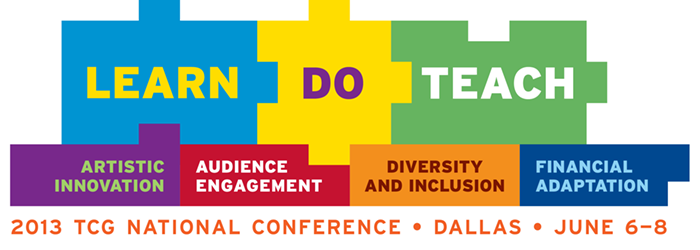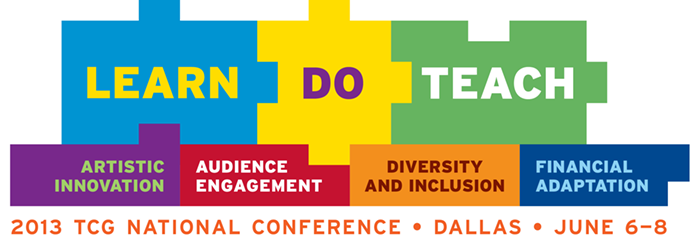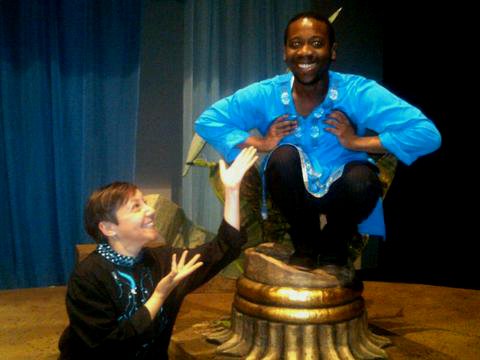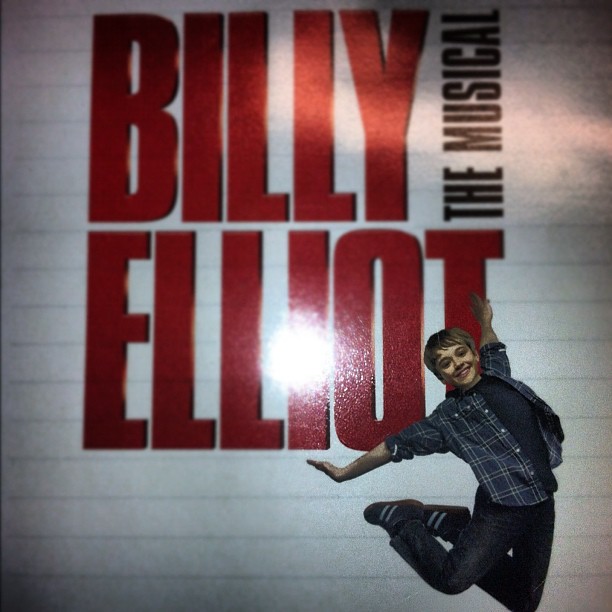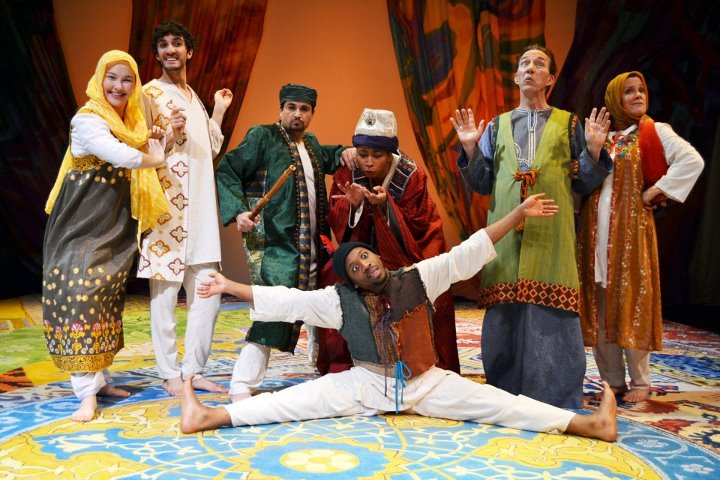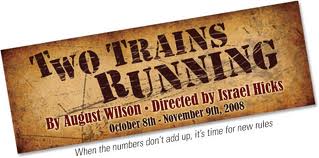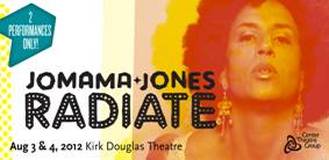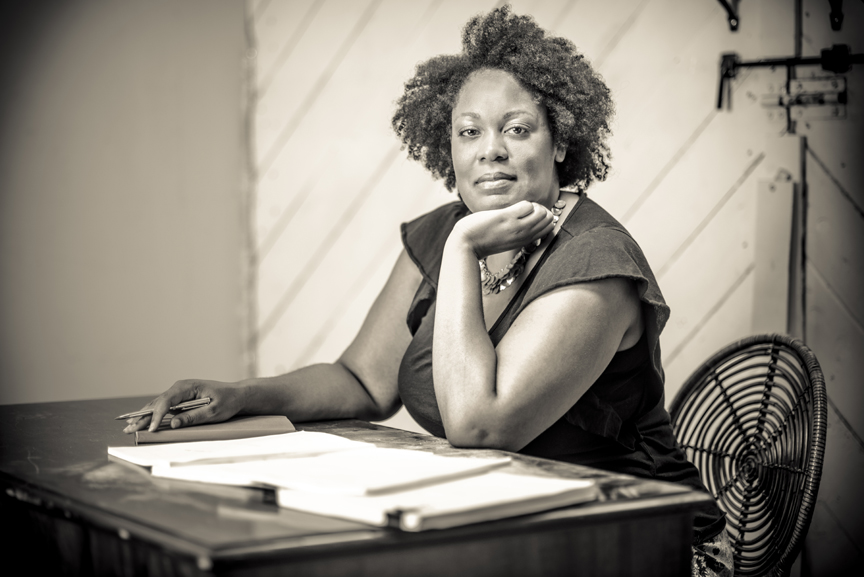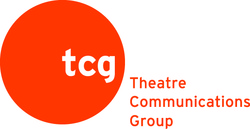 This post is a part of the Diversity & Inclusion blog salon that I led as part of the 2013 TCG National Conference: Learn Do Teach in Dallas. I am re-posting it here on my blog: I left the Diversity and Inclusion Institute completely exhausted, but in the most exhilarating and inspiring way. I was excited for the day ahead and could hardly wait to share what I had experienced in my learning sessions and homerooms. Young Leaders of Color Check-In with Teresa Eyring, Emilya Cachapero and Dafina McMillan I spent the morning writing about the Diversity and Inclusion Institute and then headed to lunch with my fellow TCG Young Leaders of Color. This year was a reunion of sorts, because new leaders had not been added owing to a lack of financial support for the program. As disheartening as that sounds, TCG is smart about how they are using this time. They are assessing on the initial goals of the program, celebrating the extraordinary efforts and achievements of the more than 70 members and working to grow the program in a new and exciting way. More on all of this as it develops, but essentially the program will be shifting from a nomination and spotlight at the conference to a year round program that offers mentorship opportunities and professional development training programs. No doubt, the enthusiasm around this idea was felt throughout the entire state of Texas! For some time, the Young Leaders of Color have wanted to be seen as a resource. One of the major ways we want to be of service is by leading diversity and inclusion training programs in organizations. This way, the burden would not have to be on the people of color in your organization. In our open discussion, the following issues were raised and deeply resonated with me:
Intergenerational Leaders of Color Check-In led by Benny Sato Ambush Following the Young Leaders of Color lunch, I headed to the Intergenerational Leaders of Color check-in led by the incomparable Benny Sato Ambush. It was a rainy afternoon, but the room was densely and beautifully packed. I couldn’t help but smile as more and more chairs needed to be added. However, I immediately saw that the room was not as diverse as it could have been. I saw very few colleagues from Asian, South Asian, Middle Eastern or Native American theatre communities. This served as a reminder to me that when we think about how to be more inclusive within our conversation about diversity, we have to think beyond Black and White. There was a strong Latino contingency, but I wanted more. The major issues raised in this conversation would appear again and again throughout the conference. Here are a few of them:
In a particularly charged moment in the discussion, there was an observation that culturally specific theatres aren’t establishing longer term relationships with artists, specifically playwrights. In response, there was an observation that culturally specific theatres don’t have the finances to compete against the larger theatres for the continued growth and life of the playwright. While I don’t think this is always the case and know of many examples where playwrights have remain invested the theatre while working a day job or even at another theatre, the financial health of the artist is an issue that came up again and again at the conference. Emilya ended the session with two inspiring gems that I had to share and actually use as guiding principles of my work:
Diversity and Inclusion Arc Homeroom: Making Change/Making Meaning - Demographic Shifts Economic Uncertainty and the Role of the Arts This session was phenomenal. It was presented by Dr. Manuel Pastor, director of the Program for Environmental and Regional Equity (PERE) at the University of Southern California. Pastor provided an humorous, enlightening and accessible look at the shifting demographic and cultural currents in our country. Author of numerous books on equity, economics, demographics and social change, Dr. Pastor is also the recipient of many grants and fellowships Danforth Fellow, Guggenheim Fellow and recipient of grants from the Irvine Foundation, Rockefeller Foundation, Ford Foundation, National Science Foundation, Hewlett Foundation, MacArthur Foundation and many more. What’s more, he’s the father of an actor/musician and a dancer. So, this conversation was passionate, informative and personal. These were the major points that spoke to me during his presentation:
Creating a Common Language: The Real Presence of Race in the Artist-to-Artist and Art-to-Audience Relationship Jasmine Guy, actress, writer and producing director of Atlanta’s True Colors Theatre Company and Susan Booth, director and artistic director of Atlanta’s Alliance Theatre spoke candidly about race relations in the rehearsal hall, the organization-to-artist relationship, and in the space between the work and the community. At the start of the conversation, Susan Booth recommended that we all read: It’s the Little Things: Everyday Interactions That Anger, Annoy, and Divide the Races by New York Times veteran Lena Williams. This is an “honest look at the interactions between blacks and whites-the gestures, expressions, tones, and body language that keep us divided.” More than anything, this discussion posited a series of powerful questions that I’d like to share here and would love your thoughts:
If you attended the conference, I’d love to hear your thoughts on these questions and any of the issues address over the course of the day. If you're interested in joining TCG's online year-round conference community, check out Conference 2.0.
0 Comments
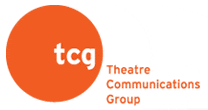 Last year, I left the TCG Conference feeling empowered, rejuvenated and inspired. I wanted to be an agent of change and a resource to my community. With my blog, I created a platform to call attention to the need for gender and racial parity in the American Theatre, and to champion the work of local theatre artists. More folks than I ever imagined possible participated in a wide range of blog series and features. I'm so appreciative of them for sharing their experiences, challenges and hopes for the future. This year's conference ended three days ago. It was five rigorous, powerful, challenging and uplifting days. I had more roles this year: Young Leader of Color, Online Conference Curator for the Diversity and Inclusion Arc and a Texas raised, D.C. based woman playwright of color, who had just opened a play. This, all of this wonder, joy and responsibility, had me working on all cylinders. On the other side of it all, I feel charged, ready and awake. I feel disrupted. I want to write. I want to take great risk. I want to create even more space for others. I have a deeper understanding of the infrastructure working against change in the American Theatre. This is at once frightening, sad and enlightening, but it also opens up room for empathy. And it is here, in this place of deep reflection and compassion, that change can happen. I love the theatre. There is a place for me here. There is a place for you here. The work we do is essential to the health, growth and vitality of ever-growing, ever-changing society. We create experiences that inform, entertain, document, hold accountable and sustain hope. We are community builders. We have the potential to ignite a revolution. With such potential for greatness, why not lead the change! 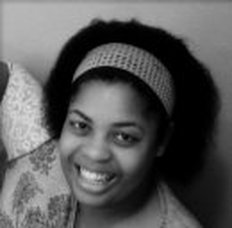 JACQUELINE LAWTON: What excited you about attending TCG's 2012 Fall Forum? YOLANDA WILLIAMS: Not only was I excited about seeing my YLC cohorts but I was excited to jump into this discussion on Diversity. I was excited to see if we were going to go beneath the surface and actually dig deep and discuss the heart of the matter in terms of Diversity in Theatre. I was anxious to share my thoughts and listen to those who truly want to address the issues and solve the problems concerning the topic- and not glaze over it with smiles and pleasantries. Jl: What were some of the common themes and challenges being addressed? YW: Defining Diversity was the biggest theme and presented the biggest challenge. As we addressed the issue and totality of its definition we realized the term ‘diversity’ was more complex and became a discussion that lead us all to reexamine our commitment to implement diversity on all levels in theatre. By tackling the issues in defining ‘diversity’ head first and having an honest and open discussion helped to a set course our need for change and action. JL: What surprised you the most about your experience? YW: I was surprised about the open and honest dialogue used in the small group discussions. When first arriving, I did not know what to expect. I thought it would be a very conservative broad overview of topics and not enough time to actually break down some common themes and problems we are facing in American Theatre. I was thoroughly impressed. Although we did not cover every problem of diversity, we did start the conversation and the movement to work towards change. JL: When considering Models for Diversity, what does it mean to have a commitment to diversity? YW: A commitment to diversity when considering Models for Diversity is making changes to diversify and tackling each challenge that blocks progression until it starts to pay off. It is realizing that it might not be the most popular decision starting out and at times or in appearance, not the most profitable one, but it the long run it would be the most beneficial to your community and your company. Ultimately your reward will be far greater than what you could have imagined. We’ve seen it time and time again by looking at the bigger picture. It’s all about being patient and investing in your community and those who make up your surrounding areas. A commitment to diversity is a commitment to your own company. JL: Where do you see Models for Diversity working in the theatre community, whether locally, regionally or nationally? What can we learn from their efforts? YW: There is a way to implement Models for Diversity throughout the theatre community, in every aspect. From front of House to actors, designers, directors, crew, producers all the way up to trustees and board of directors. If diversity is evident in the theatre from the ground up, then it can not help but to reflect the community it represents. By representing the community more people want to support it therefore creating a broader and more diverse audience. You sometimes see Models of Diversity in community theatre more than anywhere else. I believe the theatre community, regionally and nationally can learn a lot from them. In community theatre, they put on productions strictly for the sake of art and the chance to work on a piece together and bring their community out to see a show. The key word here is their community. They cast is the community in terms of the Art they are presenting. This goes beyond terms of age, race and background. The focus instead is on working together to present the work they bring to life in their production. They understand that it is the community and surrounding areas that come out and support these shows because they want to see people they can relate to on stage. They want to see people like them get on stage and bring a show to life. Without diversity where would that leave community theatre? Without diversity where would that leave theatre in general? That is just one Model of Diversity that I see present that has worked and continues to work and generate revenue. JL: What efforts have you made, or been involved with, to foster diversity competence and understanding in your community? How were these efforts met? Do you see a change? YW: I’ve been a mentor to up and coming artist in my community. I have also been working on ways to give voices to new artists by helping them produce new works. I have been working with young playwrights of diverse backgrounds and working with them to have staged readings of their works. JL: Coming out of the TCG's 2012 Fall Forum, what goals have you set for yourself to Model the Movement? YW: Two goals I set forth in progressing the push for implementing the tools I gathered from the forum: 1.) Continue to cultivate young minds and promote diversity in theatre in my community. 2.) Continue to be proactive and not wait for someone else to make a change but start the change. TCG has invited those who attended the 2012 Fall Forum on Governance: Leading the Charge and those, like me, who wish they could have attended, to keep the conversation on diversity and inclusion going. They have created a public group on 2.0 called, Leading the Charge: Advancing Diversity and Inclusion. Here, you can take part in the conversation. They've even uploaded the brilliant and useful documents and resources made available at the Fall Forum, and you can even upload your own.
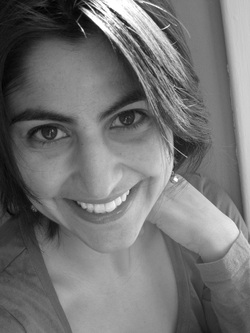 JACQUELINE LAWTON: What excited you about attending TCG's 2012 Fall Forum? MEGAN SANDBERG-ZAKIAN: It was thrilling to witness a conversation that many of us have had in bars and basements and black boxes for so long being presented as the sole focus of a formal convening for our national field! The opportunity to sit with this conversation with some of the most resourced and influential folks in the American theater, as well as other emerging leaders, was a new and thrilling experience for me. JL: What were some of the common themes and challenges being addressed? MSZ: We heard this over and over: “It’s so hard to [find board members of color/assemble a diverse hiring pool for management positions/identify strong new scripts]. We know it’s worth doing, and we want to do it, but it’s so difficult! We need resources, models, support, to make the changes we know ” JL: What surprised you the most about your experience? MSZ: I was surprised by my own strong response to this discourse of difficulty. As you will no doubt remember, Jackie, on your very blog a few months ago, I wrote a post that followed this same line of thinking, insisting that “real, meaningful change is hard.” Hearing my own language reflected back to me at the Fall Forum, it felt very negative - functioning from an assumption of scarcity and challenge, rather than abundance and possibility. I began to wonder: How might we begin to shift this discourse of difficulty that we hear so often in conversations about diversity, into a rhetoric of opportunity? After all, nothing in our work is easy; we expend enormous effort to accomplish almost everything. We are constantly surprised by new information, we encounter unforeseen obstacles, we are disappointed when proposed solutions fall short. A daily fact of our work is creative problem solving in response to the unpredictable alchemy of the live event. I wonder if this growing sense that diversity and inclusion work is just another facet of organizational excellence - like strong aesthetic values, a safe facility, a good ticketing system - might lead to a normalizing of the effort around this work. People who have some resources and power (including anyone who is selecting or casting a play, or hiring anyone, no matter how small the scale), might also benefit from recognizing that there’s some privilege to this discourse of difficulty. When we sit around the table earnestly trying to figure this out, saying “My goodness, it’s so hard to find a diverse talent pool, how can we identify more resources and support for ourselves to do this,” it is possible that we are detracting attention and resources from those we’d actually like to receive it -- our colleagues or potential colleagues who are not in position of privilege, who have been underrepresented or who have experienced discrimination, and thus have not had the opportunity to claim a seat at the table. How can we make sure that these conversations really do have the democratic benefit we hope for, rather than primarily benefiting entrenched and homogenous institutional structures which perpetuate the status quo? Personally, I do find myself in positions with resources and power, however limited, so I have been trying hard to keep this in the front of my mind. JL: When considering Models for Diversity, what does it mean to have a commitment to diversity? MSZ: You know - I’m not sure I can answer this one yet. My thinking is rapidly shifting here. Ask me again next year! JL: Where do you see Models for Diversity working in the theatre community, whether locally, regionally or nationally? What can we learn from their efforts? MSZ: The Fall Forum was full of inspirational stories from other sectors - health care, the corporate world, academia. More so than the models from our theater community, I hope for increased chances to engage with and learn from other kinds of models. I also think that small, interdisciplinary, and community-based arts organizations have been diverse and inclusive for years, in an effortless, mission-based way - it would be great to see more reflection of that in the national conversation. JL: What efforts have you made, or been involved with, to foster diversity competence and understanding in your community? How were these efforts met? Do you see a change? MSZ: It’s been exciting to see the wheels turning here in Boston. On local stages this season, we have the most number of substantive roles for non-white actors I’ve ever seen in this town (as I write this, the following shows are preparing to open: The Mountaintop, You For Me For You, Clybourne Park, Raisin in the Sun, In the Heights, Invisible Man, and By The Way, Meet Vera Stark). Our local arts advocacy organization, StageSource, was inspired by the 2012 TCG Conference in Boston to convene a “Diversity, Inclusion, and Gender Parity Task Force.” There are efforts being made to increase the diversity of our community’s designers, directors, and stage management. There is a new playwright development program specifically for female playwrights. The deaf community has been an integral part of the diversity and inclusion conversations and many companies (including mine, Central Square Theater) are learning how to be more accessible to the disabled community. So, I think the momentum of the national conversation is certainly having an impact. I’m looking forward to seeing where it goes and being part of it! JL: Coming out of the TCG's 2012 Fall Forum, what goals have you set for yourself to Model the Movement? MSZ: I’m making a personal commitment to shift my language from difficulty to opportunity - even in my own head. I’m making a larger, public commitment to doing what I can to keep the ball in the air to further these generative conversations in my community here in Boston, as well as amongst our cohort of emerging leaders, whom I learn so much from every day. Thank you all for the conversation! TCG has invited those who attended the 2012 Fall Forum on Governance: Leading the Charge and those, like me, who wish they could have attended, to keep the conversation on diversity and inclusion going. They have created a public group on 2.0 called, Leading the Charge: Advancing Diversity and Inclusion. Here, you can take part in the conversation. They've even uploaded the brilliant and useful documents and resources made available at the Fall Forum, and you can even upload your own.
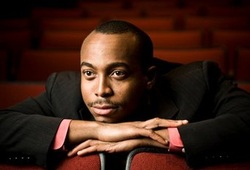 JACQUELINE LAWTON: What excited you about attending TCG's 2012 Fall Forum? AL HEARTLEY: I was excited about the chance to talk about diversity and inclusion with many leaders of the American theater. I was also particularly excited that TCG decided to invite the Young Leaders of Color who are very invested in the conversation. TCG also asked me to be a small group facilitator for the larger group conversations that we were going to have. When I looked over the curriculum, I was excited and nervous. There was a lot of ground to cover and some intimate topics that I certainly had strong opinions on. However, the nervousness was met with excitement by most that I had talked to prior Fall Forum. JL: What were some of the common themes and challenges being addressed? AH: One common challenge I felt people had was the idea of rhetoric vs. action. I think many people in the room had the rhetoric about why diversity is important. It was clear that the whole room could agree on specific examples and terms surrounding diversity and inclusion. What you also saw though, was clear disagreement on some issues with some people being very liberal on issues and others expressing more conservative views on diversity and inclusion. Despite the rhetoric though, I think people wondered where to go, how to go there, and I think most importantly, what was the litmus of when true diversity and inclusion occurred in the theater. The challenge wasn’t talking about diversity and inclusion (though there were issues at some tables). The challenge was looking past our own biases of what is diversity and inclusion and figure out how we can do more at our own theaters and within the field. JL: What surprised you the most about your experience? AH: I was surprised by how versed people were in the conversations. One exercise that we had to do was to define specific terms given to our table. The term at my table where I was the facilitator was institutional racism. I thought this was a great term to tackle, but also I was extremely nervous about it. I knew what the term meant in my eyes, but I did not think that my table would be able to tackle the term. However, this is where I was pleasantly surprised and I had to check my own biases. I had come to believe that most white people could not recognize institutional racism because they tend to be the beneficiaries of such racism. But my table, as well as others, was very adept at the various terms that were being discussed. However, it was also surprising how many people needed to start with some simple definitions. What is race? What is ethnicity? That was also surprising that people needed something that they could wrap their head around, which is a positive thing. People need to ask the question and I think that’s the central goal. JL: When considering Models for Diversity, what does it mean to have a commitment to diversity? AH: It means that with greatness and leadership comes trial, error, and even resentment from others. There are many who do not see diversity and inclusion as important or they see it as an attack on whiteness in favor of people of color. In other words, it is not simple and it is not easy. Instead, this kind of work takes a lot of effort and courage amongst people that want to fight for total diversity and inclusion. However, it does not take time. Something wonderful I heard at the TCG Conference was this: “Change does not take time. It takes new ideas.” JL: Where do you see Models for Diversity working in the theatre community, whether locally, regionally or nationally? What can we learn from their efforts? AH: One of the companies that I have looked toward in terms of Models of Diversity has been Oregon Shakespeare Festival. I have admired how they have chosen to tackle diversity and how they have approached diversity as something that should just be and not something that is forced. They also were brave enough to take the time to have the tough conversations about their organization. I also look to their diversity consultant and someone who I take a lot of my cues when it comes to diversity and inclusion, Carmen Morgan. OSF has put in place specific plans and goals when it comes to diversity and inclusion and has put the resources and investment towards equality. For instance they have a Diversity and Inclusion Planning Committee as well as an Audience Manifesto about how they will help to bring in minority communities (age, race, ability) to the theater. I look to them for tools and techniques that help to shape my own thinking. JL: What efforts have you made, or been involved with, to foster diversity competence and understanding in your community? How were these efforts met? Do you see a change? AH: I have recently moved from Chicago where I did some work with fellow colleagues at Steppenwolf that I worked with in the Multicultural Fellowship program. The fellowship specifically focused on bringing more people of color into arts administration. We also attempted to help strengthen diversity and inclusion in various ways at Steppenwolf. We had our own inclusion committee that worked with staff members to discuss issues of diversity at Steppenwolf. We also incorporated a Multicultural Social Hour where we would send out an invitation to artists in Chicago to come and have conversations with others in the community around an issue of diversity within the Chicago and US theater community. There was also a program that we modeled that encouraged our coworkers to support theater by minority playwrights as well as women. Since moving to Cleveland, I am pleased to say that I am discovering a community at Cleveland Play House that has a passion for diversity and inclusion. I would say that in Cleveland I have not seen a change yet, but I have heard vocalized from leadership that diversity and inclusion is very important to them. I look forward to working on a proposal for a diversity and inclusion statement. JL: Coming out of the TCG's 2012 Fall Forum, what goals have you set for yourself to Model the Movement? AH: I have set a goal to keep the conversation toward action. I think that there is a lot of excitement around the topic now, which is wonderful. However, I want to see conversation turn into meaningful action so that we are not just talking about the issue constantly. But there is also a goal to keep the conversation alive and to keep the movement going. I want to continue to work with communities and theaters that have a vested interest in diversity. I want to continue to be a part of programs nationally that are finding ways to promote diversity and inclusion. Anything that I can be associated with that is action based will be important to me. I also hope to continue to train with various people about promoting diversity and inclusion. TCG has invited those who attended the 2012 Fall Forum on Governance: Leading the Charge and those, like me, who wish they could have attended, to keep the conversation on diversity and inclusion going. They have created a public group on 2.0 called, Leading the Charge: Advancing Diversity and Inclusion. Here, you can take part in the conversation. They've even uploaded the brilliant and useful documents and resources made available at the Fall Forum, and you can even upload your own.
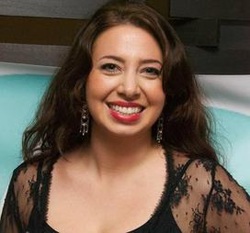 JACQUELINE LAWTON: What excited you about attending TCG's 2012 Fall Forum? J.J. EL FAR: I was excited to continue the momentum generated in the TCG Conference around diversifying and making more inclusive the theater field at large as well as nurturing the emerging young leaders of color and identifying success stories within our field leaders. I was thrilled to reconnect with my cohort of YLC'ers and looked forward to furthering our leadership training, which I found enormously useful in June. JL: What were some of the common themes and challenges being addressed? JJE: Some of my concerns coming into Fall Forum were that the conference would fail to move the conversation forward on this topic and that we would be rehashing the familiar needs and conflicts of diversifying. I also was anxious about the idea of commodifying Diversity, which seems like it echoed among my fellow YLC cohort as well. Would this be a passing phase, or were we really developing sustainable shifts within our hiring structures and season selection that would affect the field for years to come. Fortunately, I think Katori Hall's opening keynote really hit the nail on the head asking how we can transcend tokenism. Going in I wondered: Who is Diversity for? Who are we serving by Diversifying our theaters? Who is asking for it? What are well intentioned white folks supposed to do? What the hell does "White" mean anyway? And specifically, the question I asked after Katori spoke, which ended up becoming a framing question of the Fall Forum: "What would the ideal situation look like and how can we envision it so we can enact it?" I felt that we spent so much time reiterating what wasn't right and working, that we needed to flip the conversation to talk about what was. My mom, sage that she is, always tells me that I need to visualize what I want so I will be able to recognize it when I get it. Isn't that just exactly what we needed to do? Theater makers have the unique ability to envision other worlds and create scenarios that do not (yet) exist, surely we should be the leaders of the field, setting the example for other industries. JL: What surprised you the most about your experience? JJE: I was surprised that my question to the whole had such resonance with the folks at TCG and the conference as a whole. I was really grateful that we were moving in a positive direction. When we were in our small group sessions working to find group definitions of huge terms like "institutional racism," "diversity," "sexism," and "inclusion," I had a really difficult time finding language to describe these terms that wasn't already loaded with slanted meaning. I struggled deeply throughout that session. I ended up going home that night and writing six pages on the experience. A short excerpt from my rantings: "I expected this weekend to be as stimulating, overwhelming, and beneficial as the conference in June. Fortunately I was prepared this time, or so I thought. Having spent a considerable amount of time reflecting on and formulating my perceptions of the subject of diversity and inclusion, I had my pre-packaged catch phrases in command ready to pop out as readily as a pez dispenser. I had made up my mind but forgot that it still has to respond to my tongue. One of the concerns I have felt as someone socially identified as white, especially someone coming up in the 1990's was the issue of political correctness. In an age of whistle blowers, where one misinformed word can mean the end of someone's career, regardless of intention, it was a tricky time to keep up with the ever shifting moral and verbal battleground. My terminology and vocabulary have been positively uprooted. 4. When considering Models for Diversity, what does it mean to have a commitment to diversity? A commitment to diversity would look like a more colorful and cultural administrative and artistic staff, a reflection of global perspective in season choice and artists on stage, and a sincere effort to broaden audiences through expanded access and outreach. JL: Where do you see Models for Diversity working in the theatre community, whether locally, regionally or nationally? What can we learn from their efforts? JJE: I think TCG is definitely a model in this area. I think Oregon Shakespeare Festival, Cornerstone Theater, Signature Theatre, and Centerstage are leading the charge. They are placing diversity as a core value of their organizational structure and making sure that it is represented on all levels of their work. JL: What efforts have you made, or been involved with, to foster diversity competence and understanding in your community? How were these efforts met? Do you see a change? JJE: Where I live in Harlem, we have a very unique situation. In my work with the Harlem Arts Festival, part of our goal is to represent the changing and diversifying faces of the artists who call Harlem home. While the Harlem Old Guard has historically been rooted in the African Community, many artists who are not of African descent find themselves left out of the conversation to begin with and denied access to opportunities for creating and showcasing their work. I am trying to create a broader global conversation that Harlem can participate in that is reflected in the artists in our line up. We have changed the requirements for artists to be "inspired by or inspiring Harlem," notably including those that live here, and those that see themselves as part of the larger conversation. I am usually still the whitest person in the room at most community events, and its a role that I am increasingly comfortable with. I enjoy the process of breaking down stereotypes and educating folks about new definitions of culture, diversity, and what progress truly looks like. I think we have a lot further to go. It is a rapidly shifting landscape, loaded with landmines. We are keenly aware that in Harlem, the conversation is still very much about color. I hope we can move beyond that in the coming years. JL: Coming out of the TCG's 2012 Fall Forum, what goals have you set for yourself to Model the Movement? JJE: I would like to offer myself as a diversity ambassador and hopefully develop an ambassadorship program that would include my fellow YLC people. After the Fall Forum, I started the tumblr, "bindersfullofcolor," as a joke after hearing a desire expressed at the Forum for a kind of showcasing resource that would be available to theaters looking to diversify their staff. Rather than a binder, I think we should work towards having a reserve of individual artists and administrators who were available to consult and offer critical and positive feedback to an organization looking to improve in this area. We would hope that this type of program would develop a sustainable funding structure, and offer leadership and diversity training as in the YLC program for those who participate. This is an idea in progress, and I welcome your thoughts! TCG has invited those who attended the 2012 Fall Forum on Governance: Leading the Charge and those, like me, who wish they could have attended, to keep the conversation on diversity and inclusion going. They have created a public group on 2.0 called, Leading the Charge: Advancing Diversity and Inclusion. Here, you can take part in the conversation. They've even uploaded the brilliant and useful documents and resources made available at the Fall Forum, and you can even upload your own.
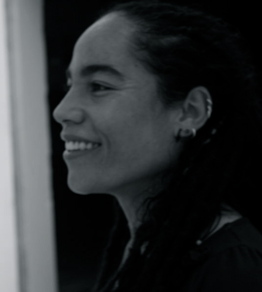 JACQUELINE LAWTON: What excited you about attending TCG's 2012 Fall Forum? KATIE CHRISTIE: I think a was most excited to see the conversation get to that for front of the conversation. 5 years ago....no one was talking about diversity and inclusion but a small group of YLC's in rooms no one knew about. Emilya asked us in our wrap up what we would like to see happen. One of the things we said was lets have this conversation with the leadership and now we have. It took a little while but it is very clear that TCG is listening to us! I'm excited to see the movement. JL: What were some of the common themes and challenges being addressed? KC: What stands out in my mind is addressing the issues of Power and Access....that came up often. Also, the mixed race conversation has finally been added to the conversation. That one was important to me...I was feeling surprised that it was not part of the conversation in LA and in Boston it really stuck out to me but I didn't have the courage to raise it...I wasn't sure that it would resinate with others. In NY I brought it up day one and it continued to stay a part of the conversation. JL: What surprised you the most about your experience? KC: So many things....I was surprised and the resistance and at the willingness to learn and change. I was surprised to see how many people were uncomfortable doing a little physical warm up with Libby....by day 2 when they heard she was come about half of the people left the room...interesting. I was not surprised but am always in awe of how many wonderful people I get to spend time with when I'm the this group. JL: When considering Models for Diversity, what does it mean to have a commitment to diversity? KC: To me it means to continue to broaden my approach to diversity and inclusion. It has always been the core part of our mission but we can continue to expand. JL: Where do you see Models for Diversity working in the theatre community, whether locally, regionally or nationally? What can we learn from their efforts? KC: Oregon Shakespeare Festival is doing an amazing job but I think everyone knows about that. I see also that the smaller theaters seem to have an easier time addressing these issues. It also seems that these organization have strong education/outreach programs in place. JL: What efforts have you made, or been involved with, to foster diversity competence and understanding in your community? How were these efforts met? Do you see a change? KC: Our whole organization is designed to promote cross cultural understand through the arts so all of our work in our community has this theme. We accomplished this simply because that was my goal when I started the organization, it's our mission, and all of our programs have always reflected that...I didn't realize it was such a problem until I came to meet with the YLC's. Everything is always changing for us because we work with youth and they are very quickly changing and adapting to a new world that is less familiar and comfortable to us older folks. Working with youth has me continuously looking at how I can better serve and enrich the lives of our youth in a way that resonates with them. JL: Coming out of the TCG's 2012 Fall Forum, what goals have you set for yourself to Model the Movement? KC: My first goal is to try to organize local theaters and share TCG's Diversity and Inclusion message because no one from my community is ever at these meetings. I will also work on bringing more people from my community to the table in Dallas. My second goal is to re-evaluate our strategies and see where we can broaden our approach. My third goal is to try to stay more engaged in the conversation between now and June. Thanks for doing this...it's been helpful for me and I hope it is helpful to you and JJ as you work with TCG on putting info together. I think it is really important for people to note how good of a job they are doing at keeping this conversation moving....I'm not sure that everyone is able to see that depending on how long they've been involved. Almost like it would be a nice example to see what it was the TCG staff took away from our meetings each year and what action they took as well as what result it produced. I have never experienced such a receptive organization. TCG has invited those who attended the 2012 Fall Forum on Governance: Leading the Charge and those, like me, who wish they could have attended, to keep the conversation on diversity and inclusion going. They have created a public group on 2.0 called, Leading the Charge: Advancing Diversity and Inclusion. Here, you can take part in the conversation. They've even uploaded the brilliant and useful documents and resources made available at the Fall Forum, and you can even upload your own.
 This past November, Theatre Communications Group (TCG) hosted its annual Fall Form on Governance: Lead the Charge. This year's focus was on Diversity and Inclusion. The Fall Forum is an intimate gathering of theatre trustees, senior staff, speakers and workshop facilitators to discuss issues of leadership and governance. While invited, unfortunately, I wasn't able to attend. I was in the midst of writing three new plays and just couldn't get away as I had hoped. However, I was able to participate in a debriefing/next steps conversation hosted by the wonderfully supportive and encouraging folks at TCG and included a handful of Young Leaders of Color and New Generations Future Leaders. In preparation for the conversation, J.J. El-Far, Megan Sandberg-Zakian and I prepared five framing questions:
The conversation felt like an extension of the work we were trained to do as Young Leaders of Color at the National Conference back in June. It was powerful, insightful and rejuvenating. Ultimately, there are no easy answers to any of these questions. The social constructs of race, culture, heritage, ethnicity and nationality have long been used as tools to allow or deny access to opportunities, resources and success. And winning the war against institutionalized exclusion will be a long and arduous endeavor. It requires patience, courage, diligence, and humility, all of which must be cultivated. I left the conversation feeling empowered and encouraged that my colleagues and I are working hard to become Diversity Ambassadors and Lead the Charge for change. As a Diversity Ambassador, the most immediate impact I have is through my work as a playwright. I write about people of color and strive to write roles for women that are strong and meaningful. When going into production, I recommend women and people of color for artistic, production and staffing positions. It's incredibly frustrating when my recommendations don't manifest as I would like, but I am committed to these issues and am in it for the long haul. As a faculty member at the University of the District of Columbia, I am able to teach my students about the world and business they're about to enter. I try instill them with the cultural awareness and sense of responsibility that they'll need in order to be strong leaders as well. Of course, I'm also excited to have this blog. In the days, weeks, months and years to come, I hope to continue having these challenging, but necessary and essential conversations about diversity and inclusion. TCG has invited those who attended the 2012 Fall Forum on Governance: Leading the Charge and those, like me, who wish they could have attended, to keep the conversation on diversity and inclusion going. They have created a public group on 2.0 called, Leading the Charge: Advancing Diversity and Inclusion. Here, you can take part in the conversation. They've even uploaded the brilliant and useful documents and resources made available at the Fall Forum, and you can even upload your own. Now, since I wasn't able to attend the Fall Forum, I asked those who were there to share their thoughts, expectations and impression. Here's who we'll be hearing from: 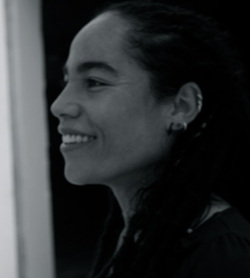 KATIE CHRISTIE Katie Christie is the Founder and Director of Voices United, Inc., which she established as a high school senior in 1989 to promote cross-cultural understanding through the performing and visual arts. Katie has facilitated and coordinated international arts programs for youth in Japan and Lesotho and directed original productions at the World Youth Congress in Quebec in 2008 and again in Instanbul in 2010. A graduate of New World School of the Arts in Miami, Florida, Katie has been recognized for her work on behalf of Voices United with diverse international accolades. In 2001, Voices United was recognized as one of the top 100 organizations addressing race and culture in President Clinton’s “Promising Practices” One America Initiative on Race. Most recently, Katie was nationally featured in “Making a Difference” on NBC’s Nightly News with Brian Williams. Before dedicating herself full time to Voices United, Katie taught drama, music and creative movement at Casa dei Bambini Montessori School on Miami Beach. She has served as Artistic Director on Peace Child International’s arts exchange programs in Russia and South Africa, and was a Facilitator at the Peace Child International Leadership Forum in Washington, D.C. She was the Advisor to the Key Biscayne Youth Council and is a member of the Theater Communication Group/Young Leaders of Colors. 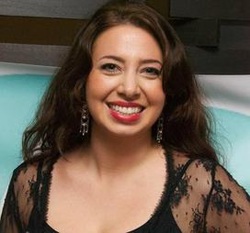 J.J. EL-FAR JJ El-Far is an Arab-American producer and interdisciplinary artist based in Harlem. She was named one of Theatre Communications Group's Young Leaders of Color. She currently holds the position of Arts Intern at the British Council in the British Consulate General. She is the Founding Executive Director of Otto Award nominated Hybrid Theatre Works, a network of theater artists engaging in cultural diplomacy through international exchange and innovative theatrical events. She is the Founding Creative Director of the multi-disciplinary Harlem Arts Festival. JJ is a Core Team member of Theatre Without Borders with whom she helped produce the “Acting Together on the World Stage” conferences at Brandeis University and La Mama. She is the contributing theater critic for Uptown Flavor. JJ has worked with The Castillo Theatre, Ted X Harlem, LaGuardia Performing Arts Center, the NY Arab American Comedy Fest, Planet Connections Theatre Festivity, Berkshire Theatre Festival, and the Jerash Festival of Arts and Culture (Amman, Jordan). She has presented at the ReOrient Festival and Forum at Golden Thread Productions, Arts in the One World at Brown University; and attended the 2010 La Mama International Symposium for Directors in Umbria, Italy. She holds a B.A. from Brandeis University in Theater Arts and International Global Studies. 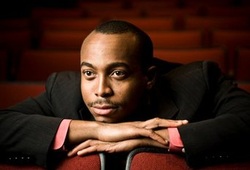 AL HEARTLEY Al Heartley is currently the Education Associate at Cleveland Play House where he coordinates and implements all education programming as well as supervises the inaugural class of apprentices. In November, Al was selected as a Small Group Facilitator for the Theater Communications Group’s 2012 Fall Forum on Diversity and Inclusion. Al was recently the Multicultural Leadership Fellow in Theater Management. He previously worked at Steppenwolf as the Casting Intern under the supervision of Associate Artistic Director Erica Daniels. While in Chicago Al worked for Writers Theater and was briefly the Associate Artistic Director of Sankofa Theater Company which is dedicated to works by minority writers. Al also focused on new plays while in Chicago working as dramaturgy support for the workshop of a play by Robert O’ Hara at Steppenwolf and directing a ready of Same Difference by Sam Roberson with Sankofa Theater. Al as assistant directed Greenetree Theater’s Yellowman under the direction of Jonathan Wilson. This past summer, Al was honored to represent Steppenwolf Theater as a Young Leader of Color at the 2012 TCG Conference in Boston. Al graduated from Florida State University with a Bachelor of Arts degree in Theater with an emphasis in Directing and Theater Studies. 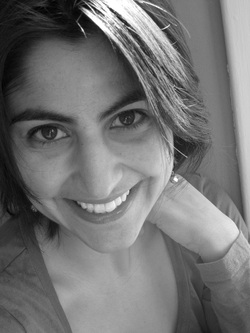 MEGAN SANDBERG-ZAKIAN Megan Sandberg-Zakian is a current recipient of the Theater Communications Group (TCG) “Future Leaders” grant to spend two seasons at Central Square Theater (Cambridge, MA), working on a series of publicly engaged development and production projects. Most recently, Megan co-developed and directed Danny Bryck's "docu-play" about Occupy Boston, No Room For Wishing, which was co-produced by CST, Company One and Boston Playwrights' Theatre, and is currently touring. Other recent directing projects include co-developing The Cabaret Series at CST, co-directing the Boston premiere of Tarell McCraney's The Brother Sister Plays at Company One (IRNE Award, Best Production; IRNE nominee, Best Director; Elliot Norton nominee, Best Production), Lydia Diamond’s Harriet Jacobs at Underground Railway Theater (Elliot Norton nominee, Best New Play; IRNE nominee, Best Ensemble, Best Actress) and the Rhode Island premiere of Hedwig and the Angry Inch at Perishable Theatre/Trinity Repertory Company (Motif Awards, Best Production, Best Set Design, Best Actor). Megan has served as Associate Artistic Director of the Providence Black Repertory Company (RI) and The 52nd Street Project (New York City). She is a graduate of Brown University and holds an MFA in Interdisciplinary Arts from Goddard College. Her production of Katori Hall's The Mountaintop can be seen at Central Square Theater January 10-February 3, 2013. www.megansz.com 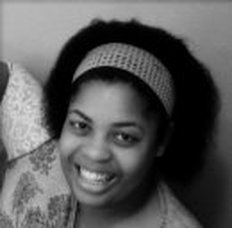 YOLANDA WILLIAMS Yolanda Williams (B.A. University of Dallas, M.F.A. University of Southern Mississippi) is a highly accomplished director, producer, educator and theatre artist with successful productions throughout her career that demonstrate her unique and innovative style in the Theatre Arts. She believes Theatre creates an understanding of the human condition by telling the story of the world while informing people of the past, present and future. Her commitment to her craft has always been based in the belief that by helping young artists understand the workings of the theatre, one is able to teach others while motivating them to build upon their individual strengths and therefore cultivate other future artists! For more information please contact Yolanda Williams at YolandaRWilliams@gmail.com. Jacqueline Lawton: Give us a little background on where you’re from originally, where you grew up, and how you ended up where you are now…
Elbert Joseph: My family is from Trinidad and Tobago. I was born in New York City and grew up in Boston. Boston is very strong diversity and arts community. JL: Why did you decide to get into theater? Was there someone or a particular show that inspired you? EJ: I decided to be an actor at age 12 after seeing Peter Pan. I wrote the casting director for the Wheelock Theater and told her that I wanted to be an actor. She cast me as a munchkin in the Wizard of Oz. The theatre transformed my life. It taught me that there are many kinds of people in the world and I no longer felt so alone. JL: What is unique about being an artist where you live? EJ: You are in place where it has a strong community that support diversity in arts and very dedicated to it. However, it will get there when all for one, one for all, meaning every artist of diversity would able to get a job in arts community. JL: You are an actor and Sign Language theatrical Interpreter and Coach. What advice can you give to theater companies wanting to work with Deaf Actors, Designers, Directors, etc.? EJ: My advice for theaters is to have patience, share knowledge and work together as artists. If you do and you respect each other, you’ll achieve success in the working environment and grow as a community. JL: Who nominated you to be a Young Leaders of Color Award Recipient EJ: Christopher Robinson, one of my peer and ASL interpreter at BU and Steve Maler, Artistic Director of Commonwealth Shakespeare nominated me for YLC. Without them, I wouldn't have been able to attend. I am grateful to them! JL: What excited you most about taking part in the conference and the program? EJ: Meeting people from all over America and the world that work in theatre and are passionate about telling stories. JL: What was the most valuable lesson you learned from the conference? EJ: I have learned that I am not alone. I have stars out there and we all as together as one. We share the passion and hunger of theater. We are working hard to transform the world into a more diverse and inclusive place for artists to work together as community. JL: What are some of the challenges you have faced as an artist of color? What have you learned from these experiences? EJ: That I have to work twice as hard as a 'Hearing' actor, but believe that I can do it. I believe that nothing is impossible. JL: What advice do you have for other young artists of color in the theatre? EJ: Stay strong and never give up your true passion. Don't give up. JL: What’s up next for you and where can keep up with your amazing work? EJ: I have few projects coming up, right now, I am interpreting for BILLY ELLIOT - Broadway touring company, after that I have few offers, but not confirmed yet..... I have two acting gig, one of them is : Arabian Nights at Nora Theatre/Underground Railway Theatre Jacqueline Lawton: Give us a little background on where you’re from originally, where you grew up, and how you ended up where you are now…
MD: I’m a native Angeleno, and if you know me, I’m always reping my City of Angels. I grew up in what is considered South Central Los Angeles and Mid City. My incredible and altruistic mother Joyce Cattenhead raised me as a single parent and is my living hero. Her devotion and unconditional love is the reason I am the man today. My father Otis Darrell is the reason why I am such an activist and lover of my people. My Grandparents Mr. and Mrs. Dallas and Great Aunt Jessica Wilson have been the elders who have always been a living testimony for me of what faith in God truly is. Their prayers, my father’s strong convictions coupled with my Mom’s love, insanely witty and brilliant organizing skills and the incredibly loving village of family, friends and church folk, make up the person people know today as Malcolm K. Darrell. My parents always desired and sought the best educational opportunities for me so it was no surprise that my adolescent educational career began at 32nd Street USC Magnet School for the Performing Arts. It was here where I learned to be an appreciative student of all things artistic. Here I learned Algebra, Jazz Trombone, Contemporary Sculpture, Folk Dance, Spanish, English all while surrounded by some of the purest forms of diversity I’ve ever encountered, it’s the reason today I have friends of all races, ethnicities and religious backgrounds. In 10th Grade I was accepted to Hamilton Academy of Music, a performing arts conservatory of the highest order at the time. With a college preparatory curriculum that included the arts equally, I was busy in High School. Most of my days started at 7:30a and ended around 6p or 10:30 -11p on show days. Hamilton is where I became a disciplined artist. Students were treated and expected to act as professionals and as a result I had a confidence when I entered U.C. Berkeley for my undergraduate training. Berkeley had a profound effect on me because of my work at Cal Performances my participation in the Theatre and Performance Studies Department, the African American Student Development office and the relationships I built which would secure my future, literally. Working in the Cal Performances box office I was exposed to some of the best international artists the human race has produced. Three seminal moments that are clear to me as if it happen all yesterday are 1. The final Company performance for the Berliner Ensemble performing Bertolt Brecht’s The Irresistible Rise of Arturo Ui. 2. Alvin Ailey American Dance theatre’s presentation of their classic ballet Slaves and 3. The soul stirring music of Cesária Évora, Cape Verde’s Barefoot Contessa! These three moments revealed to me the possibility of human connection through art. Berkeley is also where I met one of my mentors Dr. Margaret Wilkerson who would later introduce me to a dear mentor and friend the late Wesley Montgomery. From these two and my friendships at Berkeley, my life would be forever changed. From Berkeley to the New Victory in New York, to Center Theatre Group and Yale (too much learned here to describe, again life affirming experience), to the Kennedy Center and Ebony Repertory Theatre and back at Center Theatre Group I’ve had quite the journey so far! JL: Why did you decide to get into theater? Was there someone or a particular show that inspired you? MD: There were two pivotal moments when I realized I wanted to be a part of the theatre, the first was when I saw Hamilton High School Academy of Music’s production of Fiddler on the Roof. It was AMAZING! It’s the first time I believe I understood what phenomenal playwriting, composing, casting, scenic, costume, lighting and sound design were. As soon as the orchestra and chorus collided on the first notes of “Tradition!” I knew I had found my home. The second moment was seeing August Wilson’s Seven Guitars at the Ahmanson Theatre in Los Angeles. Straight from Broadway, it was my first opportunity to see professional theatrical work and to hear that singular American voice breathe life into my own people. Again I was reminded I was home. JL: What is unique about being an artist where you live? MD: Hmmm interesting question. Surprisingly, living in Los Angeles is unique for me because I’m a Native Angeleno. Most artists I come into contact are transplants and have no idea of what LA used to be and how it’s grown. Los Angeles, in all its vastness is truly my terra firma. Because of this I feel I have an invaluable network of people and resources to draw from whenever I work on a project. JL: You were the General Manager of Ebony Repertory Theatre (ERT) and currently the New Play Production Associate at Center Theatre Group. How did you get involved with these organizations? What do you hope to achieve? MD: Relationships. I constantly remind young people entering this field that you must cultivate, manage and nurture your professional relationships. I met Ebony Rep founder and producer Wren T. Brown through a mutual friend and colleague, Shay Wafer. While working with her at Cornerstone Theatre Company in the summer of 2007, she became a connector and seriously urged me to speak with Wren about his new venture. After our first meeting I knew we would be lifelong friends and colleagues I began working for ERT that November solidifying one of the greatest choices I’ve made in my life. Center Theatre Group (CTG) is a reuniting with a community that raised me as CTG was my first job after college. I worked in the department formally known as Performing for Los Angeles Youth(PLAY) coordinating the exact outreach effort, Young Audiences Program(YAP), that change my life in 1996 at the Ahmanson. Yep I’m an Alum and a living example of the power of theatre! I’ve recently returned to CTG as the New Play Production Associate because I have an insatiable passion for working with artists and producing, or creative project management for those who have no idea what we do in the theatre. JL: Who nominated you to be a Young Leaders of Color Award Recipient? MD: My awesome boss and mentor, Diane Rodriguez. Her championing of my voice has been invaluable and I owe a debt of gratitude to her for her wisdom, sacrifice and support. JL: What excited you most about taking part in the conference and the program? MD: A chance to be inspired, hear from brilliant DIVERSE minds and reunite with former colleagues and old friends. JL: What was the most valuable lesson you learned from the conference? MD: My success is found in my Core Values. Once I clearly define and operate in what I value, I have no choice but to succeed. JL: What are some of the challenges you have faced as an artist of color? What have you learned from these experiences? MD: I live in America, so I recognize there are many covert and overt ways in which racism and discriminatory practices rear their evil heads even today in 2012. Thankfully, I’ve not personally been a recipient of another human beings bigoted vitriol. However, I do work in a field that is still challenged by the notion of diversity of thought and experience. I’m not totally myself at work, because there are parts of me that are -- simply put -- culturally alien to many of my colleagues. So as DuBois coined, I live in a double consciousness, fully able to operate in a world where my other self, would never be fully accepted. Now this may seem contradictory, but the biggest lesson I’ve learned is only by expressing or revealing pieces of that cultural alien I spoke of previously, am I truly being a courageous and impactful leader. JL: What advice do you have for other young artists of color in the theatre? MD: YOU can determine your destiny, but it requires an immense amount of tenacity and relationship building. Do everything with passion, creativity, excellence, integrity and heart! JL: What’s up next for you and where can keep up with your amazing work? MD: Well I’ve just received The British Council/Los Angeles Department of Cultural Affairs Cultural Exchange International Fellowship http://usa.britishcouncil.org/cultural-exchange-international! I’ll be headed across the pond to engage with people of the African Diaspora who create and experience art from a European/British perspective. I’ll be bringing my podcast platform, Culture Connection, to the UK to have meaningful dialogue with cultural, civic, academic, community and artistic leaders. Speaking of Culture Connection, please visit me at http://www.blackisonline.com/ for my weekly segment on all things concerning cultural Arts! Please follow me on Twitter at https://twitter.com/CaliYalie, I’m always tweeting my two cents about everything from Jesus to Jimmy Fallon! |
My BlogI'm a playwright, dramaturg, and teaching artist. It is here where you'll find my queries and musings on life, theater and the world. My posts advocate for diversity, inclusion, and equity in the American Theatre and updates on my own work. Please enjoy!
Categories
All
Archives
June 2020
Reading List
|
